Places Visited: Wyoming: Pinedale and the drive from Jackson to Pinedale
along the Snake River and Hoback River.
August 13, Wind River View RV-Park
307-537-5453 Boulder, Wyoming: N42° 46.531' W109° 44.047' $24.08 Full
hookups with gravel interior roads and pads. Nice, clean park with a good laundry
and free wireless-----.
We moved the motorhome from Jackson Hole to Colter
Bay Village in the northern part of Teton National Park. That entire drive was
through Teton National Park Valley, with the mighty Tetons providing a backdrop
on our western flank. A more scenic drive is hard to find. Eight days later we
retraced our path and moved the motorhome south to Gros Ventre Campground just
north of Jackson where we spent another week.
After spending the past two
weeks in Teton National Park it was time to move on. We decided to start making
our way back to Pensacola. We aren't making a mad dash back preferring to just
amble along experiencing places and things that we have missed on previous excursions.
From
Gros Ventre Campground in Teton National Park we made our way south through Jackson
to Hoback Junction.
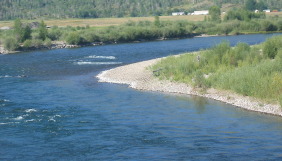

Between
Jackson and Hoback Junction US-26 follows the Snake River.
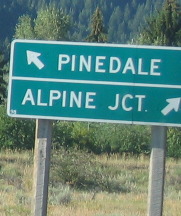
Hoback
Junction is located at the confluence of the Hoback River and Snake River. It
is also where US-191 intersects with US-26 that follows the Snake River to Alpine,
Wyoming on the Idaho border.
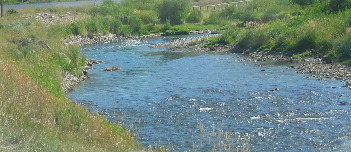
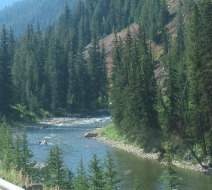
From
Hoback Junction we started following the Hoback River as we headed toward Pinedale
on US-191. The Hoback River has its headwaters in the Bridger Teton National Forest
southwest of Bondurant, Wyoming.
Somewhere
between Bondurant and Pinedale in Sublett County we passed the site where in 1811,
sixty one Astorians of the American Fur Company, the squaw of Pierre Dorian and
her two children, with one hundred and eighteen horses camped for 5-days. They
were on their way to the Pacific Ocean from Montreal via St. Louis. Here they
met, traded and powwowed with the Sake Indians, killed buffalo and cured meat.
Continuing their journey they crossed the Continental Divide near here then continued
on to the waters of the Columbia River. These were the first white men in what
is now Sublette County, Wyoming.

After
US-191/189 stopped following the Hoback River we continued toward Pinedale following
a beautiful valley with large hay fields paralleling the highway.

Pronghorn
antelope are a common sight.
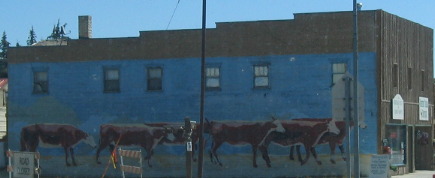
This
store in Pinedale features an attractive mural

On
the edge of this magnificent sheet of water, from 1833 to 1844, Captain William
Drummond Stewart of Scotland camped many times with Jim Bridger other Mountain
Men and Indians. In 1837, his artist, Alfred Jacob Miller, painted the first pictures
of this area. On Stewart's last trip in August 1844, eight men in a rubber boat,
first boat on the lake, honored their leader by christening these waters as Stewart's
Lake, in a joyous ceremony near the Narrows, with six-jugs of whiskey.

Years
later this glacier-formed lake with its shoreline of twenty-tow miles and over
six hundred foot depth was named after General John C. Freemont who's map makers
knew not that it had been named long before.
Fremont Lake, at the
base of the Wind River Mountains, is a natural lake formed behind a dam of glacial
debris.
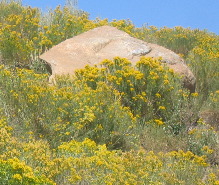
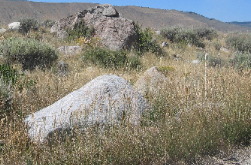
Large
boulders litter the hillsides surrounding Fremont Lake. It appears that these
large boulders were just dropped by some giant. But thanks to geologist we know
that they were dropped here by the Pinedale Glacier when it retreated some 15,000
years ago.
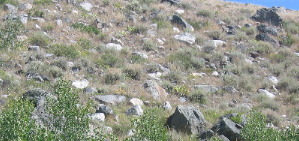

The
boulders didn't just happen, they were deposited here during the "Pinedale
Glaciation" during the Pinedale glacial advance from 70,000 to 15,000 years
ago.
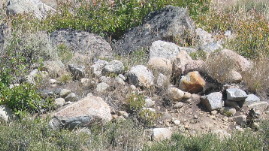

The
piles of glacial debris (moraine) are different than the cobblestones found in
the moraine piles of Teton Valley in Teton National Park. These boulders have
much sharper edges.
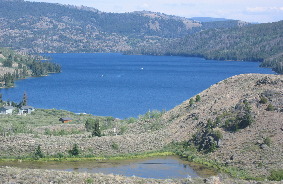

Fremont
Lake is surrounded by a huge wall of glacial debris, a moraine, that was pushed
out of the mountains and deposited thousands of years ago by the large Pinedale
glacier.


We
followed Fremont Lake road from Pinedale east to where it ended at the base of
the Wind River Range. Needless to say a highway doesn't cross the Wind River Range.
To get to the other side from Pinedale one has to utilize the highway over South
Pass just like emigrants on the Oregon Trail did over 100-years ago.

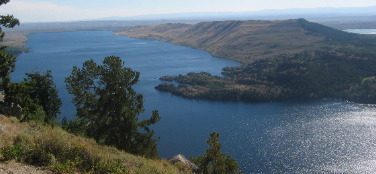
On
our way back to Pinedale we stopped at a turnout offering this panoramic view
of Fremont Lake from the eastern end high in the foothills of the Wind River Range.
Note that the sides of Fremont Lake rise abruptly from the shoreline of its 600-foot
depths. The striking depth of the lake and steep sides are the result of a glacier
that retreated thousands of years ago leaving behind this wall of glacial moraine
and deep gouge in the earth.
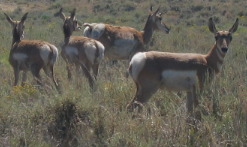
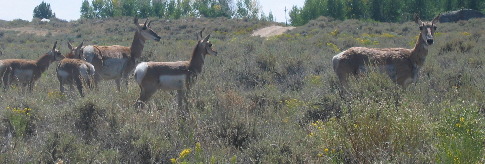
Pronghorn
antelope are a common sight in the dry open areas around the western part of Lake
Fremont.
Until next time remember how good life is.
Mike & Joyce Hendrix